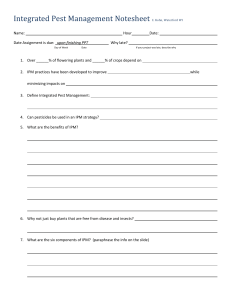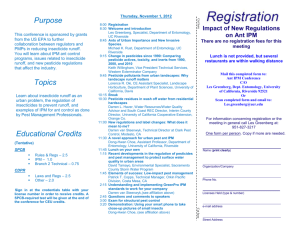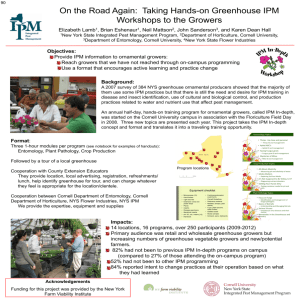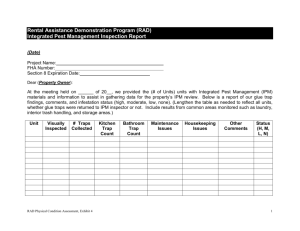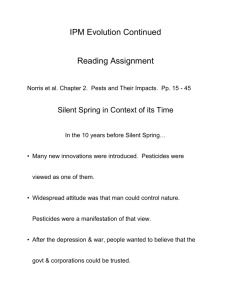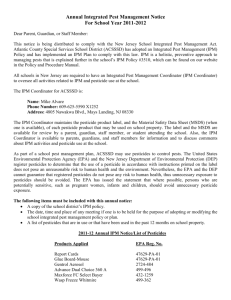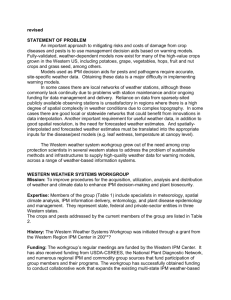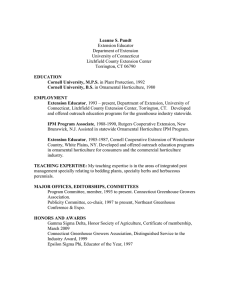II. THE ESSENTIALS OF IPM Start with a Clean Greenhouse Monitor
advertisement
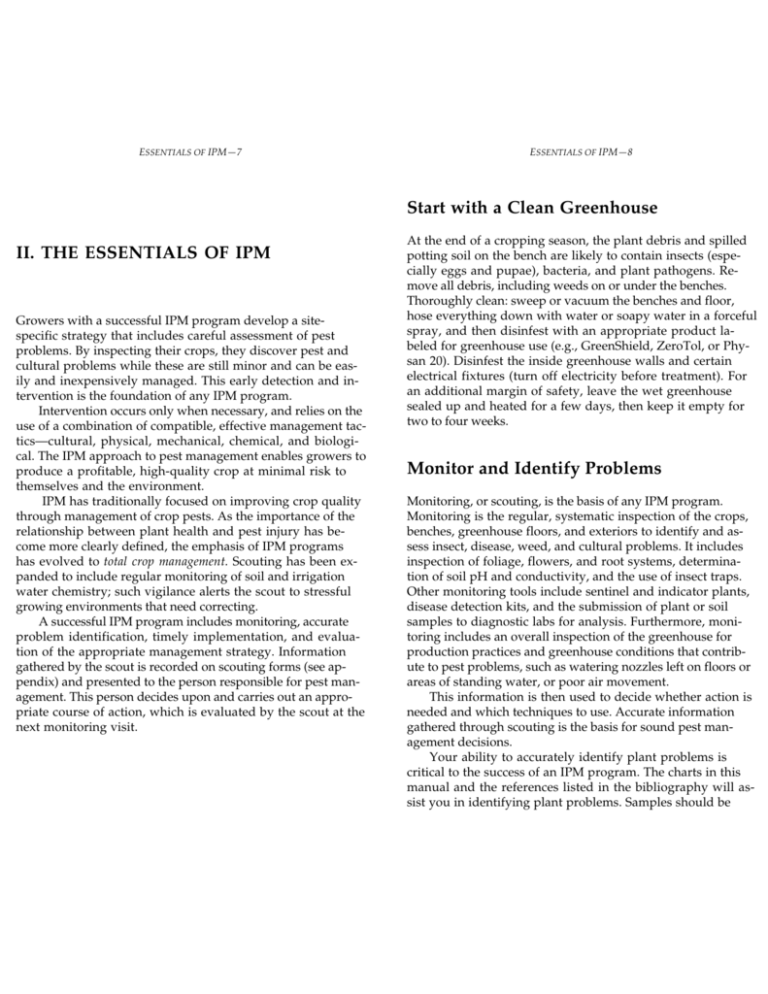
ESSENTIALS OF IPM—7 ESSENTIALS OF IPM—8 Start with a Clean Greenhouse II. THE ESSENTIALS OF IPM Growers with a successful IPM program develop a sitespecific strategy that includes careful assessment of pest problems. By inspecting their crops, they discover pest and cultural problems while these are still minor and can be easily and inexpensively managed. This early detection and intervention is the foundation of any IPM program. Intervention occurs only when necessary, and relies on the use of a combination of compatible, effective management tactics—cultural, physical, mechanical, chemical, and biological. The IPM approach to pest management enables growers to produce a profitable, high-quality crop at minimal risk to themselves and the environment. IPM has traditionally focused on improving crop quality through management of crop pests. As the importance of the relationship between plant health and pest injury has become more clearly defined, the emphasis of IPM programs has evolved to total crop management. Scouting has been expanded to include regular monitoring of soil and irrigation water chemistry; such vigilance alerts the scout to stressful growing environments that need correcting. A successful IPM program includes monitoring, accurate problem identification, timely implementation, and evaluation of the appropriate management strategy. Information gathered by the scout is recorded on scouting forms (see appendix) and presented to the person responsible for pest management. This person decides upon and carries out an appropriate course of action, which is evaluated by the scout at the next monitoring visit. At the end of a cropping season, the plant debris and spilled potting soil on the bench are likely to contain insects (especially eggs and pupae), bacteria, and plant pathogens. Remove all debris, including weeds on or under the benches. Thoroughly clean: sweep or vacuum the benches and floor, hose everything down with water or soapy water in a forceful spray, and then disinfest with an appropriate product labeled for greenhouse use (e.g., GreenShield, ZeroTol, or Physan 20). Disinfest the inside greenhouse walls and certain electrical fixtures (turn off electricity before treatment). For an additional margin of safety, leave the wet greenhouse sealed up and heated for a few days, then keep it empty for two to four weeks. Monitor and Identify Problems Monitoring, or scouting, is the basis of any IPM program. Monitoring is the regular, systematic inspection of the crops, benches, greenhouse floors, and exteriors to identify and assess insect, disease, weed, and cultural problems. It includes inspection of foliage, flowers, and root systems, determination of soil pH and conductivity, and the use of insect traps. Other monitoring tools include sentinel and indicator plants, disease detection kits, and the submission of plant or soil samples to diagnostic labs for analysis. Furthermore, monitoring includes an overall inspection of the greenhouse for production practices and greenhouse conditions that contribute to pest problems, such as watering nozzles left on floors or areas of standing water, or poor air movement. This information is then used to decide whether action is needed and which techniques to use. Accurate information gathered through scouting is the basis for sound pest management decisions. Your ability to accurately identify plant problems is critical to the success of an IPM program. The charts in this manual and the references listed in the bibliography will assist you in identifying plant problems. Samples should be ESSENTIALS OF IPM—9 submitted to a university or private lab if they cannot be accurately diagnosed at the greenhouse. IPM strategies should be timely and pest specific, because a missed diagnosis can delay implementation of the proper set of controls. Scouting methods are explained in section III. Develop a Management Plan After each scouting session, record and summarize your observations. This information includes insect identification and counts, disease incidence and severity, and location of weeds. Also make notes about cultural aspects of the crop (such as crop height and plant development) and management of soil fertility and water. Give this information to the grower along with an evaluation of the effectiveness of past controls. This information is used to formulate management recommendations, which are discussed in subsequent sections. Consider Best Management Practices Best management practices, which include integrated pest management strategies, are standard rules and routines that reduce environmental impacts. In greenhouses, following best management practices means managing fertilizers and pesticides to minimize contamination of water runoff. For example, greenhouse managers can practice good sanitation and detect pests early. They can prevent spills of concentrated chemicals by purchasing waterproof tubs and using them for secondary containment of bagged fertilizers or concentrated solutions. They can provide a locked metal cabinet for pesticides, and update the list of contents regularly. Many municipalities require businesses to avoid situations that could pollute the water table. Some logical improvements in the ways we handle chemicals in greenhouses can reduce the potential problems and the need for regulations.



